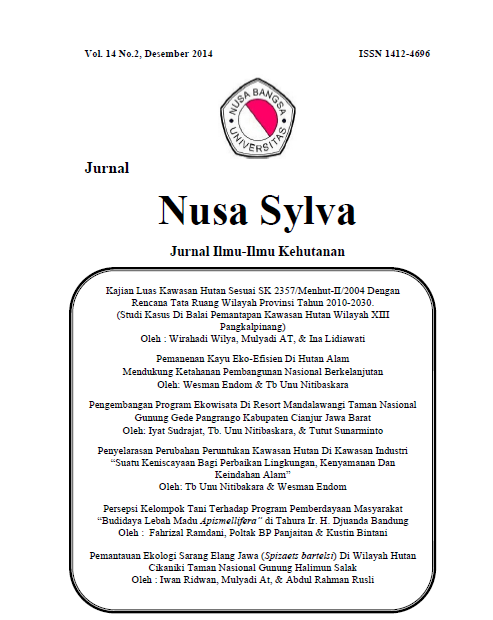PENGEMBANGAN PROGRAM EKOWISATA DI RESORT MANDALAWANGI TAMAN NASIONAL GUNUNG GEDE PANGRANGO KABUPATEN CIANJUR JAWA BARAT
DOI:
https://doi.org/10.31938/jns.v14i2.150Keywords:
Ecotourism, Program development, National ParkAbstract
Development of Ecotourism Program at Resort of Mount Gede Pangrango Mandalawangi National Park (TNGGP) is done by optimizing the supply of tourist collaborated with tourist demand. Tourism resource most interesting at Resort Mandalawangi namely Puncak Gunung Gede - Pangrango then others are rare animals such as Leopards java (Panthera pardus) is the key species and Javan Gibbon (Hylobates Molloch) as a flagship species, as well as waterfalls, crater, Blue Lake, and Gayonggong Swamp. Social and cultural potential of a pattern of community life Sundanese-oriented agriculture as well as the existence of the mythical legend of the kingdom in TNGGP. Visitors dominant male, student status with the last education of SMP / MTs, 16-20-year-old, from Bekasi to have the motivation tends to settle for pleasure. Assess visitors tend not to know that TNGGP have ecotourism program that School Visit, Visit to School, Conservation Camp, Local Content Filling Material Environmental Education / Nature Conservation and Environmental Education for Teachers, Farmers, and the Young Generation. The concept of program development of ecotourism in Resort Mandalawangi using the theme "TNGGP, Cultured Conservation Area". This concept will focus on the utilization of resources and nature taking into consideration the safety of visitors as well as integrate with shades of Sundanese culture around tourism area Cibodas. Another aspect that needs to be developed to support the promotion of ecotourism programs, establish Sundanese cultural nuances and supporting infrastructure at KWC, strengthening human resources ecotourism program managers.
Downloads
References
[IUCN] International International Union for Conservation of Nature. 2014. The IUCN Red List of Threatened Speciesversion 2014. http://www.iucnredlist.org/
[CITES] Convention on International Trade in Endangered Spescies of Wild
Fauna and Flora. 2014. Checklist of CITES Species. http://www.cites.org/
Pemerintah Republik Indonesia. 1999. Peraturan Pemerintah Republik Indonesia Nomor 7 Tahun 1999 tentang Jenis – Jenis Tumbuhan dan Satwa Dilindungi. Jakarta.
Arrijani, 2008. Struktur dan Komposisi Vegetasi Zona Montana Taman
Nasional Gede Pangrango. Universitas Negeri Manado, Tondano. Jurnal Biodiversitas Volume 9 Nomor 2 Hal 134-141.
Arrijani., Setiadi, D., Guhardja, E., Qayim, I. 2006. Analisis Vegetasi Hulu DAS Cianjur Taman Nasional Gunung Gede Pangrango. Jurnal Biodiversitas Volume 7 Nomor 2 Halaman 147- 153.
Avenzora R. 2008. Ekoturisme Teori dan Praktik. Penerbit BRR NAD-Nias. Banda Aceh
Cohen, L., Manion, L., Morrison, K. 2007. Research Methods in Education Sixth Edition. Taylor & Francis e-Library. New York. Page 101
Rangkuti F. 2001. Analisis SWOT. Jakarta (ID): PT. Gramedia Pustaka Utama.
Susila, D., Utami, T.R., Firdausi, A.N., Kurniawan, H. Dan Utami, D.S. 2011.Ekowisata Birdwatching di Kawasan Cibodas Kabupaten Cianjur Jawa Barat Bidang Kegiatan: PKMAI. Institut Pertanian Bogor. Tidak Dipublikasikan.
Wearing, Stephen dan Neil, John. 2009. Ecotourism: Impacts, Potentials and Possibilities?. Second Edition Tourism Development: Government, Industry, Policy and Planning. Oxford: Elsevier Ltd.
Downloads
How to Cite
Issue
Section
License
Copyright (c) 1970 Iyat Sudrajat, Tb. Unu Nitibaskara, Tutut Sunarminto

This work is licensed under a Creative Commons Attribution-NonCommercial 4.0 International License.













